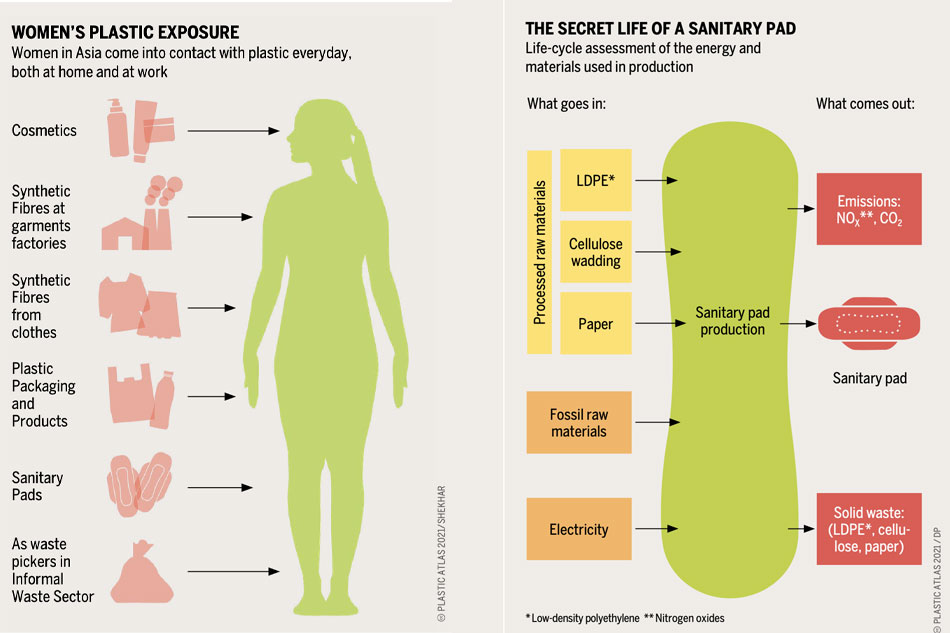Women more vulnerable to health hazards due to toxins in plastics — report | ABS-CBN

Welcome, Kapamilya! We use cookies to improve your browsing experience. Continuing to use this site means you agree to our use of cookies. Tell me more!
Women more vulnerable to health hazards due to toxins in plastics — report
Women more vulnerable to health hazards due to toxins in plastics — report
Tarra Quismundo,
ABS-CBN News
Published Apr 22, 2021 05:34 PM PHT
MANILA— From cosmetics and sanitary pads to food and drinks, women are unwittingly exposed to everyday products that could pose hazards to their health due to toxins in plastics, a report released Thursday showed.
MANILA— From cosmetics and sanitary pads to food and drinks, women are unwittingly exposed to everyday products that could pose hazards to their health due to toxins in plastics, a report released Thursday showed.
The Asia edition of the Plastics Atlas showed how known hazards of plastics on human health could be posing greater danger to women, citing their “unequal exposure” to products that contain toxic materials largely invisible while in plain sight.
The Asia edition of the Plastics Atlas showed how known hazards of plastics on human health could be posing greater danger to women, citing their “unequal exposure” to products that contain toxic materials largely invisible while in plain sight.
The risk is even more pronounced among those who work in places where plastic exposure is inevitable, such as garments factories and garbage dumps, said the report jointly published by the Heinrich Böll Stiftung Foundation, Break Free From Plastic, and the Institute for Global Environmental Strategies.
The risk is even more pronounced among those who work in places where plastic exposure is inevitable, such as garments factories and garbage dumps, said the report jointly published by the Heinrich Böll Stiftung Foundation, Break Free From Plastic, and the Institute for Global Environmental Strategies.
“Basically, it [plastic toxins] enters our food cycle from land, sea, to vegetables and fish, through to our food products sold in market and end up in our body. It results in a whole range of diseases: cancer, diabetes, mental disorder, obesity and even infertility,” said Kevin Li, program manager at Heinrich Böll Stiftung and among executive editors of the reports.
“Basically, it [plastic toxins] enters our food cycle from land, sea, to vegetables and fish, through to our food products sold in market and end up in our body. It results in a whole range of diseases: cancer, diabetes, mental disorder, obesity and even infertility,” said Kevin Li, program manager at Heinrich Böll Stiftung and among executive editors of the reports.
ADVERTISEMENT
“Women are actually more vulnerable to health hazards from plastic exposure, from plastic packaging, cosmetics, sanitary pads, clothes and even work as waste pickers,” he said in a presser.
“Women are actually more vulnerable to health hazards from plastic exposure, from plastic packaging, cosmetics, sanitary pads, clothes and even work as waste pickers,” he said in a presser.
As the report said, “biologically, women are more likely to be adversely affected by the toxins in plastics,” amplified by factors such as traditional gender roles, inequality and the still prevalent throwaway culture.
As the report said, “biologically, women are more likely to be adversely affected by the toxins in plastics,” amplified by factors such as traditional gender roles, inequality and the still prevalent throwaway culture.
“…[T]here is evidence that the toxins contained in plastics have different effects on women and men due to biological differences including body size and proportion of fatty tissue,” the report said.
“…[T]here is evidence that the toxins contained in plastics have different effects on women and men due to biological differences including body size and proportion of fatty tissue,” the report said.
For instance, phthalates, a group of chemicals used to make plastic more flexible and durable, may impact thyroid function, reduce levels of testosterone and estrogen, and may be harmful to reproductive health.
For instance, phthalates, a group of chemicals used to make plastic more flexible and durable, may impact thyroid function, reduce levels of testosterone and estrogen, and may be harmful to reproductive health.
It is more dangerous for women, as female bodies “accumulate more phthalate plasticisers and other oil-soluble chemicals” because they naturally “contain more fat than men.”
It is more dangerous for women, as female bodies “accumulate more phthalate plasticisers and other oil-soluble chemicals” because they naturally “contain more fat than men.”
“The female body is also especially sensitive to toxins during life stages such as puberty, pregnancy, lactation, and menopause,” the report said.
“The female body is also especially sensitive to toxins during life stages such as puberty, pregnancy, lactation, and menopause,” the report said.
Toxins in hygiene products
Women use more products that contain plastics, such as cosmetics in plastic containers, plastic packaging, and sanitary pads.
Women use more products that contain plastics, such as cosmetics in plastic containers, plastic packaging, and sanitary pads.
These products contain hazardous substances borne by plastics used “for functions varying from antimicrobial activity to colourants, flame retardants, solvents, and plasticisers.”
These products contain hazardous substances borne by plastics used “for functions varying from antimicrobial activity to colourants, flame retardants, solvents, and plasticisers.”
“Exposure to these endocrine disruptor chemicals can occur over the entire lifespan of plastic products, from the manufacturing process and consumer contact to recycling, waste management, and disposal,” the report said.
“Exposure to these endocrine disruptor chemicals can occur over the entire lifespan of plastic products, from the manufacturing process and consumer contact to recycling, waste management, and disposal,” the report said.
For one, typical disposable sanitary pads, which women of reproductive age use at a certain period every month, are 90-percent plastic, the report said.
For one, typical disposable sanitary pads, which women of reproductive age use at a certain period every month, are 90-percent plastic, the report said.
“With store-bought sanitary pads comprising 90 percent plastic, mass-produced feminine care products come with a hefty environmental footprint,” it said, noting that its impact on the environment happens from production to disposal.
“With store-bought sanitary pads comprising 90 percent plastic, mass-produced feminine care products come with a hefty environmental footprint,” it said, noting that its impact on the environment happens from production to disposal.
Workplace exposure
Women’s traditional work roles also place them at greater risk of exposure to plastic toxins. The report pointed out that a “disproportionate number of women work in industries that expose them to toxic chemicals present in plastics.”
Women’s traditional work roles also place them at greater risk of exposure to plastic toxins. The report pointed out that a “disproportionate number of women work in industries that expose them to toxic chemicals present in plastics.”
There are domestic workers who use household plastic products and handle waste on a daily basis, waste pickers, and workers in garments factors who “become exposed to toxins from the synthetic fibers now favored by the textile industry and widely used in fast-fashion clothes.”
There are domestic workers who use household plastic products and handle waste on a daily basis, waste pickers, and workers in garments factors who “become exposed to toxins from the synthetic fibers now favored by the textile industry and widely used in fast-fashion clothes.”
At the virtual presser, panelists emphasized the need to use “a mix of different approaches” to address the plastics crisis.
At the virtual presser, panelists emphasized the need to use “a mix of different approaches” to address the plastics crisis.
These include resource management, government regulation, a plastics ban, zero-waste initiatives, holding manufacturers accountable for production of plastic containers, and encouraging companies to come up with more sustainable product delivery systems, such as reusable containers.
These include resource management, government regulation, a plastics ban, zero-waste initiatives, holding manufacturers accountable for production of plastic containers, and encouraging companies to come up with more sustainable product delivery systems, such as reusable containers.
RELATED VIDEO
Read More:
plastics
health hazards women plastics
plastic toxins
phthalates
Plastic Atlas
BFFP
GAIA
Heinrich Böll Stiftung Foundation
women biology plastic
health hazards women
ADVERTISEMENT
ADVERTISEMENT



